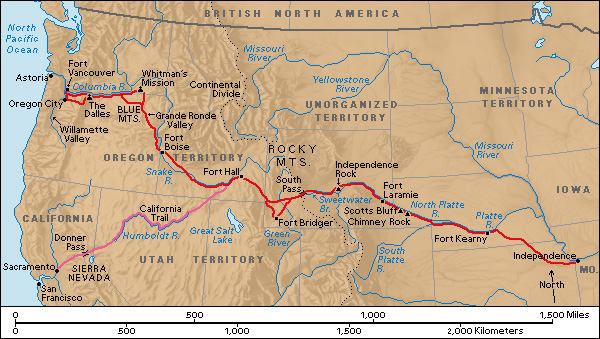Oregon Trail was the longest of the great overland routes used in the westward expansion of the United States. It wound 2,000 miles (3,200 kilometers) through prairies and deserts and across mountains from Independence, Missouri, to the Pacific Northwest. More than 50,000 people used the trail between 1841 and 1860. Even today, travelers can see the deeply rutted road cut by wagon wheels along sections of the trail.

Families traveling to the Oregon region usually began their journey at Independence, near the Missouri River. They followed a trail that ran northwest to Fort Kearny, Nebraska. Then they traveled up the Platte River and its north branch to Fort Laramie, Wyoming. From this point, they continued along the North Platte to its Sweetwater branch, and crossed through South Pass in the Rocky Mountains to the Green River Valley at Fort Bridger, Wyoming. The route turned northwest to Fort Hall in the Snake River area, and on to Fort Boise, Idaho. Settlers crossed the Grande Ronde Valley and the Blue Mountains to Marcus Whitman’s mission at Walla Walla, Washington. Then they traveled down the Columbia River to Fort Vancouver and the Willamette Valley of Oregon.
Travel on the Oregon Trail was a severe test of strength and endurance. The journey in a covered wagon took six months. Settlers often had to cross flooded rivers. Indians attacked the wagon trains, though fighting along the trail killed more Indians than settlers. Cholera and other diseases were common. Food, water, and wood were always scarce, and the travelers often encountered contaminated water holes.
Explorers and fur traders first traced the course of the Oregon Trail. In 1805, Meriwether Lewis and William Clark traveled on a western section of the route in the region of the Snake and Columbia rivers. Trader Robert Stuart also used the trail while returning from Fort Astoria. Benjamin de Bonneville is credited with taking the first wagons through South Pass in the 1830’s. Nathaniel J. Wyeth also led companies over the trail. John C. Frémont surveyed a portion of the route in 1842 for the United States Army.
Settlers began following the trail to Oregon in 1841. The first large group, about 900, used the trail in the “Great Migration” of 1843. In that year, a provisional government was organized. The Oregon Country’s northern boundary was set in 1846, and the Territory of Oregon was set up in 1848.
